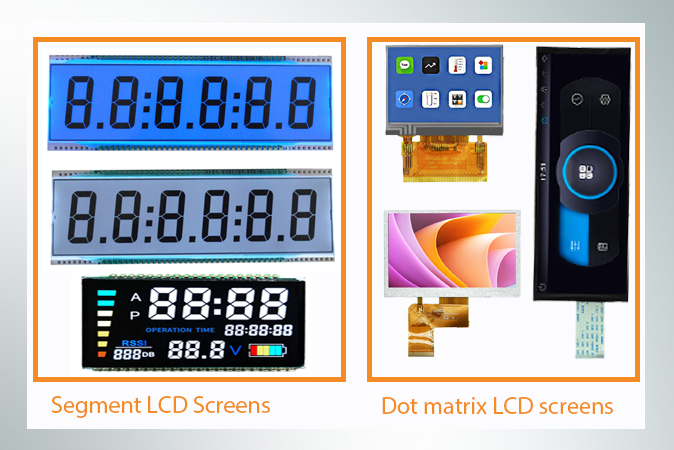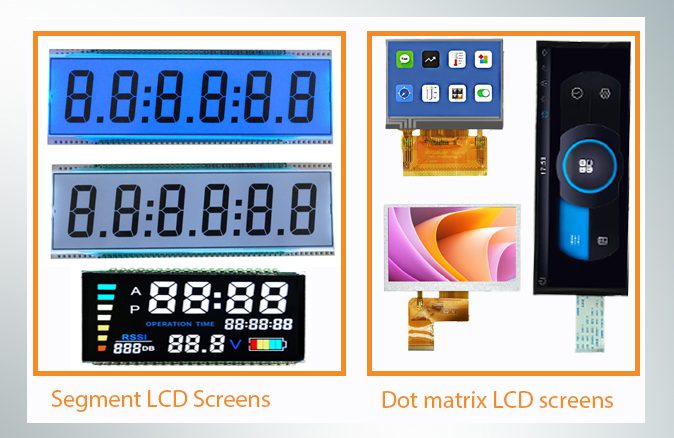Dot matrix LCD screens and segment LCD screens are two different types of LCD (liquid crystal display) technologies used in electronic devices. Here’s a we will discuss their differences from different aspects.
Display Method:
Dot Matrix LCD: Dot matrix LCD screens are capable of displaying alphanumeric characters, symbols, and graphical content by arranging a matrix of tiny dots. Each dot, known as a pixel, can be individually controlled to create different patterns and images.
Segment LCD: Segment LCD screens display characters, symbols, or numbers by dividing the screen into different segments. Each segment represents a specific part of a character or symbol, such as lines, curves, or dots.
Resolution:
Dot Matrix LCD: Since dot matrix LCD screens use a matrix of individual pixels, they offer higher resolution and can display more detailed graphics and text.
Segment LCD: Segment LCD screens have lower resolution compared to dot matrix LCD screens. They are primarily used for displaying simple characters or symbols, such as numbers or basic icons.
Flexibility:
Dot Matrix LCD: Dot matrix LCD screens are more flexible in terms of content and layout. They can display various fonts, sizes, and graphical elements. This flexibility allows for more complex user interfaces and graphics.
Segment LCD: Segment LCD screens have predefined segments, limiting the display to specific characters or symbols. They are suitable for applications that require simple and standardized information, such as digital watches or calculators.
Cost:
Dot Matrix LCD: Due to their higher resolution and increased flexibility, dot matrix LCD screens are generally more expensive to produce compared to segment LCD screens.
Segment LCD: Segment LCD screens are relatively simpler in design and have fewer components, making them more cost-effective.
Power Consumption:
Dot Matrix LCD: Dot matrix LCD screens typically require more power to operate due to their higher resolution and the need to control individual pixels.
Segment LCD: Segment LCD screens consume less power compared to dot matrix LCD screens, as they have fewer segments to control.
Overall, dot matrix LCD screens offer higher resolution, greater flexibility, and the ability to display more complex graphics. On the other hand, segment LCD screens are simpler, cost-effective, and suitable for applications that require basic character or symbol display. The choice between the two depends on the specific requirements and constraints of the device or application where they are used.
Check More Information of Dots Matrix TFT LCD Display: 1.3″-24″ TFT LCD Module
Rjoytek Custom different TFT LCD Display, which Tailor-made LCD solution, if you need help, feel free to Contact Us !

Application field of dot matrix LCD screen and segment LCD screen
Dot Matrix LCD Screen Applications:
1: Electronic Devices: Dot matrix LCD screens are commonly used in devices such as smartphones, tablets, laptops, and digital cameras to display high-resolution images, videos, and user interfaces.
2: Gaming Consoles: Many handheld gaming consoles utilize dot matrix LCD screens to provide detailed graphics and text for gaming experiences.
3:Industrial Equipment: Dot matrix LCD screens find applications in industrial equipment like measuring instruments, control panels, and machinery displays, where the ability to show complex data and graphical representations is essential.
4: Automotive Displays: Dot matrix LCD screens are used in car dashboards, infotainment systems, and instrument clusters to provide detailed information, navigation displays, and multimedia content.
5: Medical Devices: Medical equipment, including patient monitors, diagnostic devices, and medical imaging systems, often incorporate dot matrix LCD screens for displaying vital signs, medical images, and patient data.
Segment LCD Screen Applications:
1: Digital Watches and Clocks: Segment LCD screens are widely used in digital watches and clocks to display time, date, and other basic information.
2: Calculators: Segment LCD screens are commonly found in calculators for displaying numbers, mathematical operations, and basic symbols.
3: Home Appliances: Many household appliances, such as microwave ovens, washing machines, and thermostats, use segment LCD screens to show timers, temperature settings, and other simple information.
4: Fitness Trackers: Segment LCD screens are often employed in fitness trackers and wearable devices to display step count, heart rate, and other fitness-related information.
5: Point of Sale (POS) Systems: Segment LCD screens are used in cash registers, price scanners, and POS systems to display prices, product codes, and transaction information.
While these application fields provide a general overview, it’s important to note that LCD technology is versatile and continuously evolving, and the choice of LCD screen type can depend on factors like cost, power consumption, and specific display requirements for each application.

